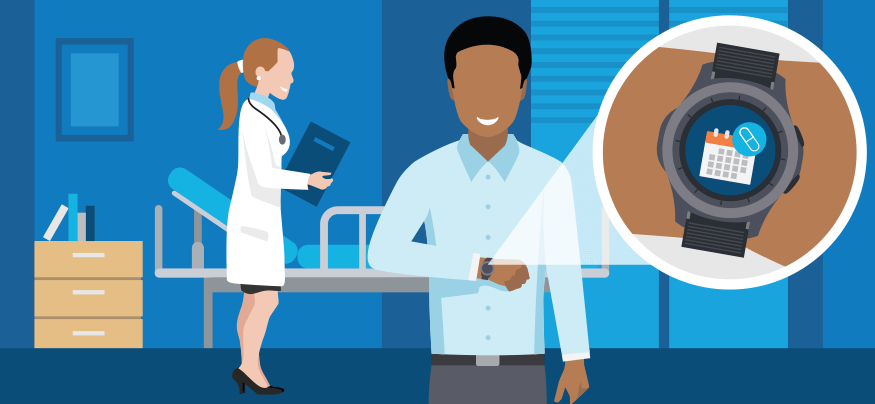Every day, healthcare practitioners seek ways to use technology to reduce readmission rates and improve outcomes for patients with chronic illness. Healthcare workers are not alone in this fight. Patients with chronic disease also want easier ways to self-manage their conditions and maintain their health. For both groups, wearables have provided a way to living an easier life with chronic conditions.
Managing a chronic condition can seem overwhelming and time-consuming. It may involve the manual tracking of statistics like blood sugar readings or heart rate. This manual tracking relies on the patient to remember to take the measure and then accurately record the data for the doctor to review at a later time. Patients welcome devices that automatically monitor key vitals, gather relevant data and send reminders that make it easier for them to monitor their disease.
Here are a few ways wearable devices and other monitoring technologies provide health benefits to people with chronic conditions:
- Exercise is often added to the treatment plan for a wide range of chronic conditions. Fitness-focused wearables can automatically track activity levels and some provide real-time heart rate monitoring. These devices can offer motivation to reach fitness goals and even help customize a wellness program. Results can be shared with a healthcare provider to demonstrate compliance with a treatment plan.
- For patients with Alzheimer’s, vascular dementia or cognitive challenges, wearables can help with wayfinding and navigation. Small tracking devices, which may be embedded in jewelry, wallets, shoes and phones, can help caregivers check-in with patients. Phones and smartwatches may also send reminders for medication or doctor appointments.
- People with diabetes look for better care with mobile access to blood sugar levels. To help manage the condition, continuous glucose monitoring (CGM) transmitters can connect to smartphone applications. CGM transmitters can alert if blood sugar levels are too high or low, and the patient can take the appropriate steps. CGMs are able to gather data about how particular foods or activities impact blood sugar levels. This data can help patients and care teams identify particular patterns, and develop a targeted plan for insulin doses.
Reduce Readmission Rates with Wearables
See how home healthcare agencies are using wearables and tablets to make their work easier. Download Now
These examples show how wearables help patients stay vigilant and in control of their own care. With current and accurate data, patients can track and then respond to a health issue before it becomes urgent. With this information at their fingertips, patients are able to mitigate the effects of a chronic illness, reduce their time spent in a hospital or even prevent the need for a hospital stay.
Identifying Beneficial Wearables for Patients
Health teams see firsthand the costs, both financial and personal, that chronic disease exacts from their patients. They also see the impact on the sector as a whole. Of the $2.7 trillion spent annually on healthcare in the U.S., 86 percent is used to treat people with chronic and mental health conditions, notes the Centers for Disease Control and Prevention.
Health practitioners are open to technologies that will help them and their patients better control the effects and costs of these conditions. Healthcare teams take a proactive role in improving patient outcomes when they stay updated on the latest wearable technologies. Staying familiar with how wearables fit into a chronic illness treatment plan makes health practitioners better advocates and advisors to their patients.
When healthcare teams choose wearable devices for their patients, what are they looking for?
- Accurate and timely data: Wearables can automatically track and record data that can then be shared with health providers. These devices may track heart rate, activity levels, blood sugar readings and other vital statistics. Rather than relying on the patient to measure and record this data, the device does it automatically. Physicians and nurses can then download readings from the device to get a clear picture of patient health.
- Ease of use: Every consumer wants their high-tech devices to be easy to use. This is true for patients and their care teams. Using technology should be simple enough that the patient will comply with using the device. If the user experience is poor, it reduces the incentive for the patient to wear it. Downloading and examining data gathered by the wearable technology also should be uncomplicated for the healthcare professional, allowing for quick and easy access to medical data.
- Remote monitoring capabilities: Heavy patient loads for physicians often means they cannot schedule as many in-office visits as needed for their chronically ill patients. And patients with chronic conditions may have wellness issues that prevent in-person visits to their doctor. In response, healthcare teams have seen the benefits of remote patient monitoring. The chronically ill are an at-risk patient population; remote visits can offer a way to monitor this group to prevent hospital admissions or readmissions and to adjust treatments before larger health issues arise.
- Security features: Wearable devices collect sensitive and personal data about the wearer. Healthcare providers look for devices that incorporate security features like authentication controls and encryption into the device itself, as well as how data is transmitted and stored. Depending on the device, providers can leverage Samsung Knox to incorporate secure logins and data storage.
Following a treatment plan is a key part of successful condition management. Wearable technology can often provide the essential link between physician and patient, since a doctor cannot always be with each patient and insist they exercise or take medication.
Wearable devices can offer these reminders to patients, assisting them in staying compliant with treatment plans. These devices allow both the patient and care provider to see collected data, revealing areas of progress and those in need of improvement. The result is what both sides are looking for when it comes to managing health: better communications and better outcomes.
Learn more about how healthcare technology solutions can enhance efficiencies and improve the patient experience.








